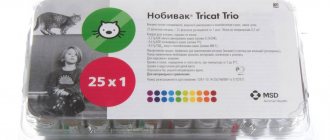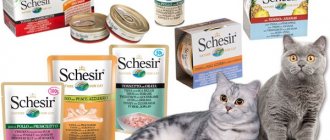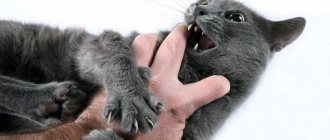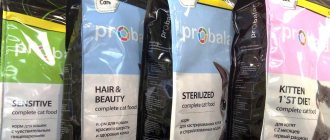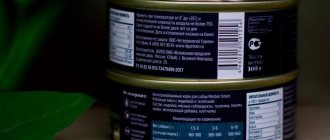Description
Felocell 4 (Felocell 4) 1 dose, 2 bottles.
International nonproprietary name: vaccine against viral rhinotracheitis, calicivirus infection, panleukopenia and chlamydia in cats with a solvent. Dosage form: vaccine - lyophilized tablet for solution (dry weight); solvent - solution for injection (liquid). The vaccine is made from attenuated strains of infectious rhinotracheitis virus (strain FVRm), calicivirus (strain F-9), feline panleukopenia virus (strain Snow Leopard) and Chlamidia psittacci (strain Baker) with the addition of casein solution (12.5±0.5%) , gelatin solution (4±0.5%), sucrose solution (10±0.5%) and gentamicin (30 μg/ml). Solvent - water for injection (1 ml). In appearance, the vaccine is a dry porous white mass, and the solvent is a colorless transparent liquid. The vaccine components are packaged in 1 ml (one dose) in plastic bottles of appropriate capacity, hermetically sealed with rubber stoppers reinforced with aluminum caps.
Why do you need to vaccinate cats?If your cat does not go outside and does not communicate with other animals, this does not mean that she has no place to become infected and that she does not need vaccination. You may well bring the infection into your home on your shoes, clothes and hands. The excretions of sick cats containing pathogens end up in the soil. You carry particles of this soil in the form of dust and dirt home on your shoes. Some “caring” owners bring their pets weed from the street. It’s impossible to list all the ways to get infected. Do not think that it is unlikely that your cat will become infected in this way. Once the cat gets sick, it will no longer matter whether the probability of infection was 80% or 0.15%. For some diseases, the mortality rate is very high - about 70% of cats die when infected with panleukopenia. Rabies is fatal in 100% of cases, including in humans. And you can become infected with rabies from almost any animal, including rats and mice—cats’ favorite prey. A vaccine is a specific set of viruses, weakened or killed (inactivated). Their introduction into the animal’s body stimulates the production of antibodies, which accumulate in the body after the vaccine is administered, and when a live virus enters the body, the antibodies kill it. Vaccinated cats, if they get sick, tolerate the disease much easier and in a less life-threatening form. Unvaccinated animals do not have such antibodies in their blood, and their bodies require considerable time to produce them. In kittens, the immune system has not yet been formed and works very slowly, so they are more susceptible to infectious diseases. At what age should you vaccinate? Vaccinations begin at 12 weeks of age. This is the age when antibodies received from the mother can no longer fight viruses coming from the environment. It is not recommended to have vaccinations while teeth are changing, but they change from 4-5 months to 6-8 months. It must be remembered that with mother’s milk the kitten receives a certain amount of antibodies - but only if the cat was vaccinated in a timely manner and had active immunity at the time of birth. Antibodies received from the mother remain in the kitten’s blood for up to 2.5-3 months. That is why it makes no sense to carry out primary vaccination of animals born from vaccinated mothers before 2-3 months: killed or weakened viruses received with the vaccine will simply be neutralized by ready-made antibodies. And active immunity will not develop. If the mother cat has not been vaccinated, then vaccination can be carried out 3-4 weeks earlier. An absolutely healthy animal must be vaccinated, having undergone deworming before vaccination. The presence of diseases and parasites weakens the immune system and, as a result of vaccination, few antibodies can be produced, and then even a vaccinated cat can get sick. In addition, if a cat has worms, vaccination can cause serious complications, including death. Here are some good remedies for worms: Drontal, Milbemax, Cystal-Cat, Kanikvantel, Polyvercan . After 10 days, deworming must be repeated, since the medicine does not affect the eggs and larvae of worms. After the first deworming, you need to wait until the larvae mature and kill the newly born worms in the second dose. The most optimal period is 10 days; waiting longer is not recommended. 10 days after the last anthelmintic, the first vaccination can be done. 21 days after the first vaccination, revaccination is necessary. It has been clinically proven that with a single primary vaccination, proper immunity is not achieved and if a large amount of virus or a very pathogenic strain enters the body, the body may not be able to withstand the load, the immune system will not cope and the kitten will get sick. Even if you are vaccinating an adult cat for the first time, the scheme remains the same. Revaccination is not necessary for rabies. Next, the cat must be vaccinated annually at the same time or a little earlier without revaccination.
What is the best way to vaccinate? There are two types of vaccines live and dead . Live vaccines contain a weakened live virus. Live vaccines are prepared from apathogenic attenuated pathogens. Viruses lose their pathogenic properties, but retain the ability to reproduce. An infection artificially caused by the introduction of a vaccine continues for a certain time, is not accompanied by a clinical picture of the disease and stimulates the formation of immunity to pathogenic microorganisms. Live vaccines are believed to provide longer-lasting and stronger immunity than dead vaccines. BUT you should remember such points as
- Spontaneous mutations.
During the multiplication of the virus in the cat’s body, unpredictable changes in the genetic structure and the return of the pathogenicity of this microorganism are possible. In this case, the cat will get really sick.
- Coinfection (joint infection) with wild virus. Simultaneous infection with a vaccine virus and a wild one is very dangerous, although unlikely.
- If the cat's immune system is weakened, vaccination may lead to the development of the disease.
Due to the fact that live vaccines are made on the basis of living microorganisms, a number of requirements must be observed to ensure the preservation of the viability of microorganisms: Live vaccines should be stored and transported at a temperature of 4-8 ° C. Freezing live vaccines does not affect their properties. Live vaccines quickly lose their immunogenic properties at room temperature. Violation of the integrity of ampoules and bottles can render the drug unusable.
Dead (inactivated) vaccines contain a killed whole microorganism or fragments. They are killed by physical (temperature, radiation, UV light) or chemical (alcohol, formaldehyde) methods. For dead vaccines, immunity is developed immediately after administration, and for live vaccines - on the 6-7th day: in the first days, viruses actively multiply, and only then immunity begins to develop. Dead vaccines are not able to multiply in the body: immunity is developed from the small number of killed microbial bodies (or their fragments) that are introduced. Therefore, dead vaccines are safer - they cannot lead to the development of a viral disease. But they cause less effective and long-lasting immunity. Dead vaccines: Felovax (Fel-O-Vax ) - a vaccine against panleukopenia, rhinotracheitis, calicivirus and chlamydia; The vaccine contains inactivated feline panleukopenia virus, two strains of feline calicivirus, inactivated feline rhinotracheitis virus and the causative agent of feline chlamydia (Chlamydia psittaci). Contains thimerosal, neomycin, polymyxin B and amphotericin B as preservatives. Manufacturer Fort Dodge Animal Health, USA. Felovax LV-K (Fel-O-Vax Lv-K) is a vaccine against viral leukemia. Manufacturer: Fort Dodge Animal Health, USA. Multifel - a vaccine against panleukopenia, rhinotracheitis, calicivirus and chlamydia; The vaccine contains inactivated feline panleukopenia virus, two strains of feline calicivirus, inactivated feline rhinotracheitis virus and the causative agent of feline chlamydia (Chlamydia psittaci). , Russia. ChlamyKon is a vaccine against feline chlamydia (strain K-1). Inactivated vaccine. Produced by JSC Vetzverotsentr, Russia. Nobivac rabies is a vaccine against rabies that contains an inactivated culture of the rabies virus. Manufacturer: Intervet Schering-Plough Animal Health, Netherlands. Rabizin is a vaccine against rabies. Contains inactivated strain of rabies virus GS-57 WISTAR. Manufacturer: Merial S.A.S. (Merial SAS), France. Leukocell 2 (Leukocell 2) . The vaccine against viral leukemia contains inactivated feline leukemia virus (FeLV) and FOCMA antigen. Manufacturer: Pfizer Animal Health, USA.
Live vaccines: Leukorifelin – vaccine against panleukopenia, rhinotracheitis, calicivirosis. Contains attenuated feline panleukopenia virus, a solution of the glycoprotein fraction of feline herpesvirus and purified feline calicivirus antigen. Quadricat – vaccine against panleukopenia, rhinotracheitis, calicivirus and rabies; contains attenuated feline panleukopenia virus, a solution of the glycoprotein fraction of feline herpesvirus, purified feline calicivirus antigen and inactivated rabies virus. Manufacturer: Merial S.A.S. (Merial SAS), France. Nobivac Tricat is a vaccine against panleukopenia, rhinotracheitis, calicivirosis. Contains attenuated feline panleukopenia virus (Bristol strain), a solution of the glycoprotein fraction of feline herpesvirus (strain G 2620) and purified feline calicivirus antigen (strain F9). Manufacturer: Intervet Schering-Plough Animal Health, Netherlands. Nobivac FORCAT is a vaccine against panleukopenia, rhinotracheitis, calicivirus and chlamydia. Contains inactivated feline panleukopenia virus strain MW-1, feline calicivirus strain F9, feline rhinotracheitis virus strain G 2620A and chlamydia strain Baker. Manufacturer: Intervet Schering-Plough Animal Health, Netherlands. Felocell CVR (Felocell CVR) is a vaccine against panleukopenia, rhinotracheitis, calicivirosis. Contains live attenuated strains of infectious rhinotracheitis virus, calicivirus and feline panleukopenia virus. Manufacturer: Pfizer Animal Health, USA. Purevax . Purevax RCP – vaccine against panleukopenia, rhinotracheitis, calicivirosis; contains attenuated feline rhinotracheitis herpesvirus, inactivated feline calicivirus antigens and attenuated feline panleukopenia virus. Manufacturer: Merial S.A.S. (Merial SAS), France. Purevax RCPCh is a vaccine against panleukopenia, rhinotracheitis, calicivirus and chlamydia. Contains attenuated feline rhinotracheitis herpesvirus, inactivated feline calicivirus antigens and attenuated feline panleukopenia virus, as well as attenuated feline chlamydophila (the causative agent of feline chlamydia). Purevax FeLV is a vaccine against viral leukemia. Contains recombinant canarypox virus in the genome of which the FeLV gene has been expressed using genetic engineering. Manufacturer: Merial S.A.S. (Merial SAS), France. Primucell FIP is a vaccine against infectious peritonitis. Contains attenuated coronavirus. The vaccine is administered through the nose. First used in 1990. Manufacturer: Pfizer Animal Health, USA. Katavac Chlamydia is a vaccine against feline chlamydia. Manufacturer: Fort Dodge Animal Health, USA. All companies that produce these drugs recommend revaccination with the same drug as the primary vaccination. The effectiveness of vaccination can be significantly reduced due to the use of immunoglobulins, sulfonamides or antibiotics a few days before the vaccine is administered and a month and a half after. You need to buy vaccines only at a veterinary pharmacy. Vaccinations completed are recorded in the veterinary passport. This passport is necessary for participation in exhibitions, when traveling abroad and for proper vaccination throughout the cat’s life. Vaccines for the treatment and prevention of lichen (trichophytosis and microsporia): Microderm , Polivac TM for cats, Vakderm - F for cats. These vaccines create immunity of short duration (2-3 weeks). In addition, there is a high probability that a healthy animal will get shingles after vaccination - the vaccines are live. It should also be kept in mind that shingles is not fatal. It is easily treated and can be avoided by following basic hygiene and pet care rules. Therefore, these vaccines are used mainly for TREATMENT, not PREVENTION, of lichen.
Most vaccines allow you to vaccinate a cat against the three most dangerous viral diseases - panleukopenia, calicivirus and rhinotracheitis. Some of them also protect against chlamydia. The rabies vaccination can be done separately, or the combined vaccine quadricat can be used. There are also separate vaccines against feline viral leukemia and against FIP (feline infectious peritonitis), but the effectiveness of these vaccines, especially the FIP vaccine, is widely questioned.
There are no vaccinations against worms, fleas and other parasites. Such offers are a scam.
Doses and method of administration
Kittens are subject to vaccination from 12 weeks of age. The vaccine is administered twice with an interval of 3-4 weeks subcutaneously or intramuscularly in a volume of 1 ml. Revaccination of animals is carried out once a year with one dose of vaccine. Before use, add 1 ml of solvent into the vaccine vial using a sterile syringe and shake thoroughly. Sterile syringes and needles are used to administer the vaccine. The surface of the skin at the injection site is treated with 70% alcohol. Violation of the vaccination schedule should be avoided, as this may lead to a decrease in the effectiveness of immunoprophylaxis for viral rhinotracheitis, calicivirus infection, panleukopenia and feline chlamydia. If the next dose of vaccine is missed, immunization should be carried out as soon as possible.
Restrictions and unwanted actions
Revaccination of the animal must be carried out strictly according to the schedule; if it is violated, the effectiveness of immune prophylaxis against rhinotracheitis of viral origin, calicivirus, chlamydia and panleukopenia decreases. In case you missed a vaccination, you should get it quickly. Vaccination of weak or sick cats is not recommended. It is prohibited to use the medicine after the expiration date.
Both when using other vaccines and when receiving Felocel injections, allergies can occur. With such a reaction, the animal needs to undergo certain symptomatic treatment.
Biological properties
The vaccine causes the formation of an immune response to pathogens of viral rhinotracheitis, calicivirus infection, panleukopenia and chlamydia in cats, 21 days after repeated administration, lasting 12 months. One immunizing dose of the Felocel 4 vaccine contains no less than: infectious rhinotracheitis virus - 105.7 TCID50; calicivirus - 106.2 TCID50, feline panleukopenia virus - 103.0 TCID50 and Chlamydia psittacci - 103.2 TCID50. The vaccine is harmless and has no medicinal properties.
When should I start getting vaccinated?
The first vaccination for kittens is done at the age of 8-10 weeks . By this time, they are already switching to independent feeding and stop receiving antibodies from their mother’s milk.
If the mother cat has not been vaccinated, vaccinations for kittens begin at 5-6 weeks of age.
Revaccination (repeated administration of the vaccine to cats) is usually carried out 3 weeks after the first vaccination. Its purpose is to strengthen immunity and prolong the effect of the vaccine. Vaccination for cats is repeated at intervals of one year throughout their life.
It is not advisable to vaccinate kittens when their teeth change from 5 to 8 months. During this period, their immunity is reduced.
It is imperative to deworm kittens and cats 7-10 days before vaccination.
Personal prevention measures
When working with the vaccine, you should follow the general rules of personal hygiene and safety precautions provided for when working with veterinary medicinal products. All persons involved in vaccination must be provided with special clothing. If the vaccine accidentally gets on the skin and/or mucous membranes, they must be washed with plenty of clean water. If the drug is accidentally administered to a person, the injection site must be treated with a 70% ethyl alcohol solution and contact a medical facility.
